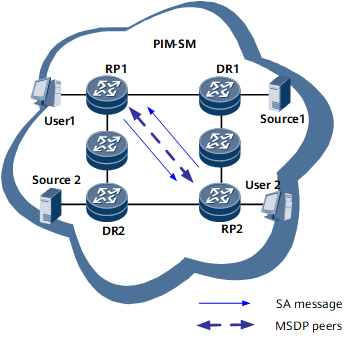Anycast-RP in MSDP
Usage Scenario
In a traditional PIM-SM domain, each multicast group is mapped to only one rendezvous point (RP). When the network is overloaded or traffic is heavy, many network problems occur. For example, the RP may be overloaded, routes may converge slowly if the RP fails, or the multicast forwarding path may not be optimal.
To resolve those problems, Anycast-RP is used in MSDP. Anycast-RP allows you to configure multiple loopback interfaces as RPs in a PIM-SM domain, assign the same IP address to each of these loopback interfaces, and set up MSDP peer relationships between these RPs. These configurations help select the optimal paths and RPs and implement load splitting among the RPs.
If Anycast-RP is not applied to a PIM-SM domain, multicast source information and multicast group joining information needs to be aggregated to the same RP. As a result, the load of a single RP is heavy. Anycast-RP can resolve this problem. In addition, a receiver sends Join messages to the nearest RP, and a multicast source registers with the nearest RP, which ensures the optimal RP path.
Implementation Principle
As shown in Figure 1, in a PIM-SM domain, the multicast sources, S1 and S2, send multicast data to the multicast group G. U1 and U2 are members of group G.
The implementation process of Anycast-RP in the PIM-SM domain is as follows:
RP 1 and RP 2 establish an MSDP peer relationship to implement intra-domain multicast.
The receiver sends a Join message to the nearest RP and sets up a rendezvous point tree (RPT). The multicast source registers with the nearest RP. RPs exchange source active (SA) messages to share multicast source information.
Each RP joins a shortest path tree (SPT) with the source's designated router (DR) at the root. After the receiver receives the multicast data, it determines whether to initiate the SPT switchover.
